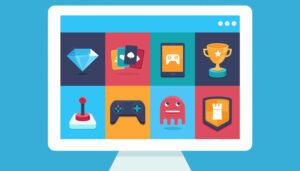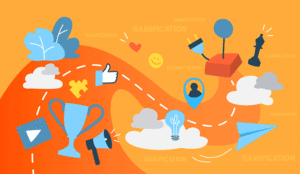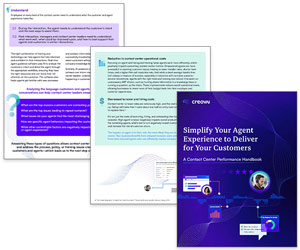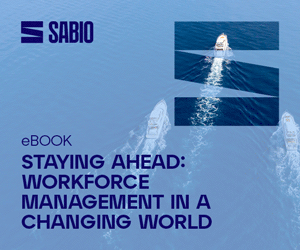We define gamification, before exploring how it is being used in contact centres to improve performance.
What Is Contact Centre Gamification?
“Gamification is the craft of deriving all the fun and engaging elements found in games and applying them to real-world or productive activities,” according to Yu-Kai Chou, an experienced entrepreneur and business consultant.
This is our favourite definition of gamification, as it specifies that, despite the name, gamification is not the same as gameplaying.
If we think about gamification only through this lens of points, badges and leaderboards, these initiatives will likely fall stagnant and often won’t link to a higher meaning.
Gamification Is a Leadership Technique
So, instead of thinking about gamification as gameplay, we need to think of it as a leadership technique, as Alex Hickson, Head of Telemarketing at Payzone, tells us.

Alex Hickson
Alex says: “We need to understand our human drivers and lead by recognizing the feelings, behaviours and insecurities within our team, finding out what makes individual advisors do and not do something.”
“Then, we want to optimize those feelings to elicit the behaviours that we want from the team. That is what gamification is.”
This may have you thinking: why is the leadership technique called “gamification” then?
Well, great games are engrossing, they push you forwards for one reason or another. So, gamification involves considering how can we take that almost obsessive engagement and apply it to our business.
As we later discuss, gamification can be applied to four key areas of contact centre leadership. These are:
- Internal Communication
- Motivational Games
- Incentives
- Contact Centre Software
But before we explore these areas further, we need to understand a little bit more about how gamification works…
Gamification and Our Core Drivers
Following Yu-Kai Chou’s thought process for gamification, he realized that almost every game is fun to someone because it appeals to certain core drivers that motivate us.
Yet different types of games use different techniques to push you forwards. Some are inspiring and empowering, while others may have more of a manipulative and obsessive edge to them. But, either way, they are motivating and push you forwards.
So, by Yu-Kai Chou’s definition, gamification involves finding out what motivates our team and making sure that we hit their “key drivers” in our leadership, in order to inspire the team to perform better.
A Method for Understanding the Contact Centre Team’s Core Drivers
The following model is put forward by Yu-Kai Chou, which he calls his “Octalysis of Core Drivers”. This highlights every driver of motivation that exists within us.
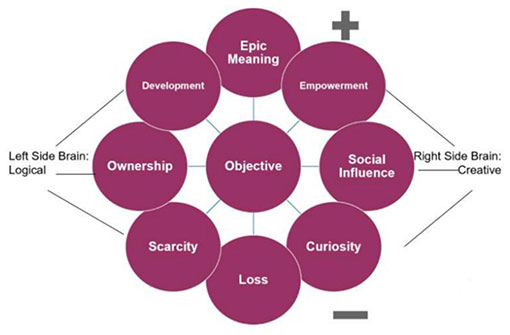
Everything that we do in the contact centre will link back to one of these core drivers. So this can be a great framework for gamification, as if we can appeal to all of these, we can better engage and motivate our staff towards a common goal.
“Every human fits onto this Octalysis model. You have those who are positively motivated towards a goal or towards being number one. Then you have the negatively motivated, those people that just don’t want to finish bottom or perhaps even don’t want to get the sack,” adds Alex.
“You also have the logical left side of the model and human brain and the creative right side, to cover all of our core drivers. So, if you hit all of this Octalysis, you are appealing to the whole team.”
Making These Core Drivers Actionable for Gamification
The following diagram, which was developed by Grant Williams of Legal & General, explores each of the core drivers highlighted in Chou’s Octalysis model from a contact centre perspective.
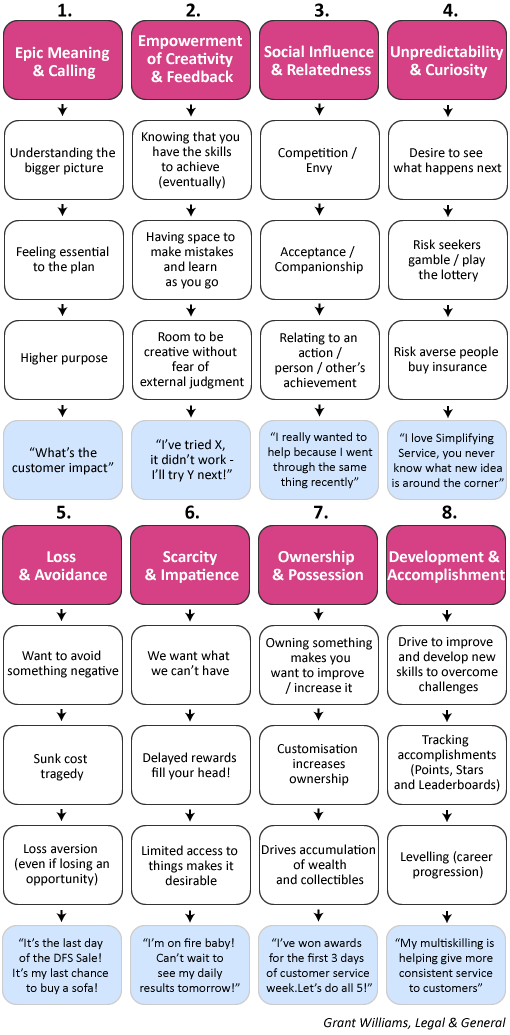
By taking a close look at the diagram, we can gain a better understanding of what we can do to hit each of these eight criteria in our contact centre leadership.
Every true gamification model will involve hitting core motivation drivers, just like the eight presented in Chou’s model.
Applying Gamification to Internal Communications
Gamification can be applied very well to our internal communications. This goes for both verbal and written communication, but let’s first consider a written example.
Just think about the last time your team received an email from higher management and it landed badly.
You might have heard comments like: “They’re so out of touch,” or: “They have no idea what goes on down here.” This is the type of email that needs to be looked at again by assessing each of our team’s key motivators and applying gamification.
Take that email and rewrite it in consideration of the Octalysis model… you will see for yourself the massive change that the new email will have. This is an example of applying gamification.
So, take that email and rewrite it in consideration of the Octalysis model, or however else you may choose to understand your team’s key drivers, and you will see for yourself the massive change that the new email will have. This is an example of applying gamification.
It is particularly good to do this in email communication, as tonality and intent is often lost. However, verbal communication is also important, as we discuss in the example below.
Using Gamification for Overtime Requests
It’s good to think about gamification as we plan what we are going to say in huddles and team briefs. But let’s find a better way to bring this to life.
Let’s take a look at the common contact centre scenario of asking advisors to work overtime and see how we can apply gamification to work out how we can appeal to each of our advisors’ core drivers.
We are using the eight core drivers in Chou’s Octalysis model as an example of how to use gamification to improve our overtime uptake.
Epic Meaning and Calling – Ensure there’s an understanding of why we need advisors to work overtime and make sure the team feel essential to our plan.
Empowerment of Creativity and Feedback – Here we can allow advisors to choose their own overtime slots, so perhaps we can put a timetable up on the wall and the team can fill in the hours that they want to do.
Social Influence and Relatedness – If an advisor can find a friend to work overtime with them, perhaps they can win a small bonus or prize, as they are bringing someone else along.
Unpredictability and Curiosity – Maybe we could provide a raffle ticket for every hour of overtime worked and that would appeal to those risk seekers.
Loss and Avoidance – We could remind advisors that this is the last overtime opportunity of the year, so it may perhaps be their last chance to earn extra money before Christmas, for example.
Scarcity and Impatience – Spreading a message of: “If you don’t work this one, you can’t work the next one” can make the upcoming overtime option more desirable for some advisors.
Ownership and Possession – Can advisors customize their overtime schedule? Perhaps with a colleague they could split an eight-hour shift into two four-hour shifts?
Development and Accomplishment – This is the category where leaderboards, points and badges come in. So, can we incentivize advisors who do lots of overtime with career progression opportunities?
From this example, we can see that we are trying to hit every core driver of engagement to gamify the contact centre while improving our performance.
Three More Areas to Apply Gamification in the Contact Centre
While we have shared an example of applying gamification to the scenario of asking advisors to work overtime, there are many more situations to which gamification lends itself well.
Alex has highlighted four key areas where she has found gamification to be beneficial in her contact centre.
1. Motivational Games
Games are a great way to use gamification as, after all, they are closely linked with this idea of “obsessive engagement”.
However, it will be difficult to create games that apply to each of the eight core drivers. So it can be good to plan ahead and mix and match games to appeal to every motivator.

Brett Brosseau
As Brett Brosseau, Vice President of Noble Gaming Solutions, says: “Change what you compete on. Make sure the same people aren’t winning all the time, as that can be demotivating for the rest of the contact centre team.”
“Incorporating ‘most improved’ awards are incredibly impactful for motivating employees of all skill levels within an organization.“
By changing the games, we can also keep advisors on their toes and prevent a fun activity from becoming an expectation.
2. Incentives
Incentivizing advisors is a tricky task, as what is motivating for one advisor may not be for others.
But while you will have your larger incentive schemes, you will also likely use other incentives throughout the year, because motivation is a behaviour that is influenced by immediate consequences.
“While advisors need to know where they are going, you have to celebrate the micro-successes, you’ve got to keep people on their toes and provide regular updates…transparency is a powerful motivator,” adds Brett.
So we must understand what motivates individual advisors and use our time with them to focus on their journey to win the incentive, motivating them largely through the core driver that is most relevant to them.
For more on how to optimize your contact centre incentive schemes, read our article: How to Improve Your Employee Reward Schemes – With Examples
3. Software
While technology isn’t needed to implement any of this, it can absolutely help to embed it. However, you should ensure that you understand everything that has been discussed before you go ahead and part with your company’s money.
There are many aspects of gamification and the whole process requires human follow-up. To some, getting a car to the end of the race track means nothing unless it’s followed up by a pat on the back by the manager.
It’s also important to choose the company that you partner with wisely too. Are you working with a company that also understand those human roots? This is important to know, as some vendors may be flexible with their definition of gamification to best suit their technology.
Just a Warning – Make Sure Gamification Aligns With Each of Your Team’s Core Drivers
We can’t just assume that, for certain decisions, we don’t have to think about each of our team’s core drivers.
Why?
“Because our contact centres are filled with such a variety of people and we cannot assume that they are all motivated in the same way,” says Alex.
I might assume that all of the advisors in my team are positively motivated, competitive risk-lovers – but I would be wrong.
“I might assume that all of the advisors in my team are positively motivated, competitive risk-lovers – but I would be wrong. Some of my top sellers are the more negatively motivated people.”
There is a second reason to be aware of the various drivers of obsessive engagement. This is that every human has each of these drivers within them. It’s not all about each advisor’s core driver.
While one driver may not be a dominant emotion for the advisor, they will still be influenced by the other criteria. Even the most risk-averse people may get a small kick out of a raffle ticket.
With this in mind, only by applying each of our advisors’ core drivers to our leadership can we engage every person and every part of each person.
In Summary
“Intelligent gamification changes the way that employees interact with their work and their colleagues, to drive the right behaviours and, consequently, improve emotional engagement,” as Brett tells us.
Such improvements in engagement through using gamification have resulted in a number of other benefits in Alex’s contact centre.
These benefits include shrinkage falling by half, productivity rising by 7.5% and conversation rates growing by a massive 20% – as measured against a control group.
So, by applying gamification to communication, games, incentives and software in particular, you can obtain some real benefits – especially considering that these figures were recorded after just one month!
Just remember, gamification is not gameplay. It’s about understanding our key human drivers and assessing how we can create the same obsessive engagement that many of us find when playing games and apply that to the workplace. Octalysis is a great tool for doing this.
Good luck!
For more on gamification and other related topics, read our articles:
- Using Gamification to Increase Contact Centre Engagement
- An Introduction to… Gamification
- How to Use Contact Centre Incentives to Improve Performance
Author: Robyn Coppell
Published On: 20th Nov 2019 - Last modified: 12th Aug 2025
Read more about - Technology, Communication Skills, Editor's Picks, Employee Engagement, Fun and Games, Gamification, Incentives, Noble Systems, Performance Management









